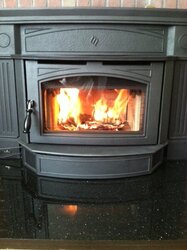Hello, we just installed Hampton HI300. 6" double wall, 30' liner top to bottom with well-sealed blocking plate. I am old Vermont Castings Vigilant stove user who quickly discovered this is a much different type of stove to run and I would like anyone's input who has experience setting up long slow burns.
Specifically, I was running the stove for about 5 hours nice an easy, one log at a time last weekend and it was doing very well. I was really impressed so I decided to load it up with my well seasoned oak and see if she would go through the night. About 30 min later, I couldnt seem to control the fire and it was getting excessively hot. Even with the damper rod open 1/2" and the fan on low (as manual instructs) the secondary tubes were glowing red and it all seemed to be worsening. Disregarding the manuals instruction to make sure the damper was open at least a smidge with the fan on, I shut the damper but It didn't seem that the damper was fully choked even with the rod fully pushed in. Fortunately I've read enough on this forum about the cooling effects of opening the door (slowly) so I did that and slowly began to tame the burning beast. I really dont want that to happen again so I have a few questions; does anyone know how close the logs can/should be allowed to get to the secondary tubes (did I put them up too close? Is there such a thing?)? Although the stove says it can take 18" logs, I am getting the sense I should've been using smaller pieces. Thoughts/observations on that? Is anyone finding that loading logs left to right or front to back is working better? I've read the manual portion about the recommendation of leaving a "trench" down the middle in the embers so the air can move to the back. Anyone know about any negative effects of not doing that? II'm wondering if when I loaded I blocked that path and that's what caused the overfire. Any experienced input on the stoves successful operation is appreciated.
Specifically, I was running the stove for about 5 hours nice an easy, one log at a time last weekend and it was doing very well. I was really impressed so I decided to load it up with my well seasoned oak and see if she would go through the night. About 30 min later, I couldnt seem to control the fire and it was getting excessively hot. Even with the damper rod open 1/2" and the fan on low (as manual instructs) the secondary tubes were glowing red and it all seemed to be worsening. Disregarding the manuals instruction to make sure the damper was open at least a smidge with the fan on, I shut the damper but It didn't seem that the damper was fully choked even with the rod fully pushed in. Fortunately I've read enough on this forum about the cooling effects of opening the door (slowly) so I did that and slowly began to tame the burning beast. I really dont want that to happen again so I have a few questions; does anyone know how close the logs can/should be allowed to get to the secondary tubes (did I put them up too close? Is there such a thing?)? Although the stove says it can take 18" logs, I am getting the sense I should've been using smaller pieces. Thoughts/observations on that? Is anyone finding that loading logs left to right or front to back is working better? I've read the manual portion about the recommendation of leaving a "trench" down the middle in the embers so the air can move to the back. Anyone know about any negative effects of not doing that? II'm wondering if when I loaded I blocked that path and that's what caused the overfire. Any experienced input on the stoves successful operation is appreciated.



